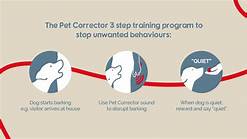How to Use a Pet Corrector
Pet correctors are devices that emit a high-pitched sound or spray a citronella mist when activated. They are used to deter pets from engaging in unwanted behaviors, such as barking, chewing, or jumping on furniture. While pet correctors can be an effective training tool, it is important to use them correctly in order to avoid causing stress or anxiety in your pet.

How to Choose a Pet Corrector
The first step in using a pet corrector is to choose the right one for your pet. There are two main types of pet correctors: ultrasonic and citronella. Ultrasonic pet correctors emit a high-pitched sound that is inaudible to humans but can be very startling to pets. Citronella pet correctors spray a fine mist of citronella essential oil, which has a strong, unpleasant odor that most pets find aversive.
The best type of pet corrector for your pet will depend on their individual personality and preferences. If your pet is sensitive to noise, an ultrasonic pet corrector may be a good option. If your pet is more stubborn or less sensitive to noise, a citronella pet corrector may be a better choice.
How to Use a Pet Corrector
Once you have chosen a pet corrector, you need to learn how to use it correctly. Here are some tips:
- Start by reading the manufacturer's instructions carefully. Each pet corrector is different, so it is important to follow the instructions for the specific product you are using.
- Introduce the pet corrector to your pet gradually. Start by letting them sniff it and get used to the sound or smell. Once they are comfortable with the pet corrector, you can start using it to correct their behavior.
- Only use the pet corrector when your pet is actually engaging in the unwanted behavior. Do not use it as a punishment after the fact.
- Be consistent with your use of the pet corrector. If you only use it occasionally, your pet will not learn to associate the sound or smell with the unwanted behavior.
- Praise your pet when they behave well. This will help them to understand what you want them to do instead of the unwanted behavior.
Troubleshooting
If you are having trouble getting your pet to respond to the pet corrector, there are a few things you can try:
- Make sure that you are using the pet corrector correctly. Read the manufacturer's instructions carefully and follow them exactly.
- Try using a different type of pet corrector. If your pet is not responding to an ultrasonic pet corrector, try a citronella pet corrector. Or vice versa.
- Be more consistent with your use of the pet corrector. If you only use it occasionally, your pet will not learn to associate the sound or smell with the unwanted behavior.
- Praise your pet when they behave well. This will help them to understand what you want them to do instead of the unwanted behavior.
- Consult with a veterinarian or behaviorist if you are still having trouble getting your pet to respond to the pet corrector.
Declaration: All article resources on this website, unless otherwise specified or labeled, are collected from online resources. If the content on this website infringes on the legitimate rights and interests of the original author, you can contact this website to delete it.





